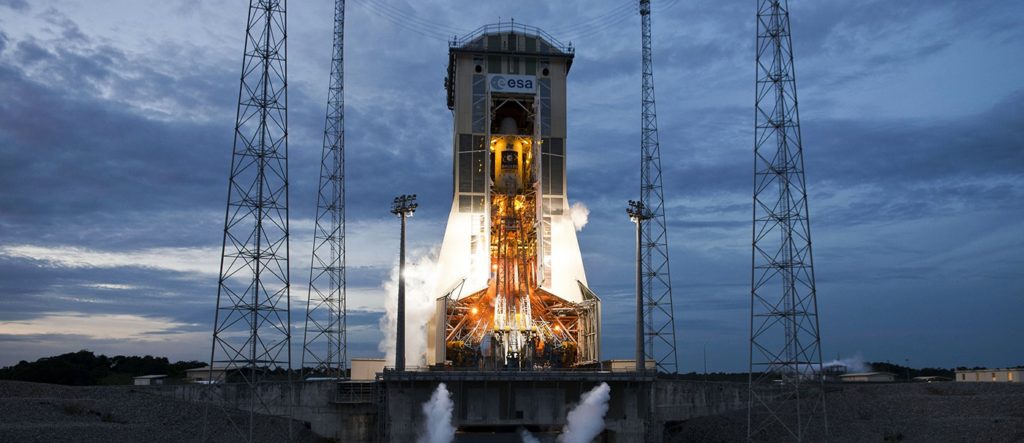Ariane operations began in 1979 with the Ariane 1 version. Since then, more than 220 Ariane flights have been performed from the Spaceport, where the Ariane 5 now operates as Arianespace’s workhorse heavy-lift launch vehicle.
Arianespace’s launcher family was expanded in 2011 with the introduction of its medium-lift Soyuz at French Guiana, and joined in early 2012 by the lightweight Vega.
With the three launch vehicles in full operation, Arianespace is targeting a flight activity of approximately 10 missions per year from French Guiana – composed of an average seven Ariane 5 flights annually, plus two Soyuz missions and a Vega launch.
A position of importance
The Spaceport’s location close to the equator at 5.3 deg. North latitude makes it ideally situated for missions into geostationary orbit. Launching near the equator reduces the energy required for orbit plane change maneuvers. This saves fuel, enabling an increased operational lifetime for Ariane satellite payloads – and, in turn, an improved return on investment for the spacecraft operators.
The French Guiana coastline’s shape allows for launches into all useful orbits from northward launches to -10.5 deg. through eastward missions to +93.5 deg. The area also has a low population density and is protected from hurricanes and earthquakes, providing it with unique advantages as a highly operational launch site.
Ariane 5 launch site
Ariane 5 missions are performed from the Spaceport’s ELA-3 launch zone, which is one of the world’s most modern facilities, and was built specifically to serve the workhorse heavy-lift vehicle.
Here the vehicle is positioned over a concrete foundation with three flame trenches. Liquid oxygen/liquid hydrogen feed lines for the launcher’s cryogenic main stage are hooked up via connectors under the launch table, as are the connections for the umbilical mast.
The launch zone has four 80-meter-tall towers that provide lightning protection, and a tower that delivers water to the launch site for cooling and noise damping during Ariane 5’s liftoff. A separate metallic tower equipped with baffles helps protect the launcher from air turbulence created by wind acting on the launch table’s umbilical mast and the launch vehicle itself.
Checkout, control, safety and coordination of Ariane 5 launch campaigns is handled by ELA-3’s launch center, which is located at a 3-km. safe distance from the launch zone.
The protected building includes operations room, meeting rooms, offices and other facilities to support the approximately 100 persons involved in an Ariane 5 countdown. An adjacent three-story building houses all services required for a launch campaign’s technical and operational management through to the start of final countdown.
Soyuz launch site
The Spaceport’s Soyuz launch site combines the proven design elements from the long-existing launch site at Baikonur Cosmodrome with satellite integration procedures that are in concert with the spacecraft processing used for Ariane missions.
Located 12 kilometers northwest from the existing Ariane 5 launch complex, the new Soyuz facility extends the Spaceport’s operational zone further up the French Guiana coastline.
The assembly of Soyuz vehicles is handled horizontally in the launcher integration building, maintaining the process used for the more than 1,840 Soyuz missions performed to date.
The Soyuz’ transfer to the Spaceport’s launch zone is performed with the launcher riding horizontally atop a transporter/erector rail car. Soyuz is then raised into position on the pad, and in contrast with the Baikonur Cosmodrome processing flow, is protected by a gantry that moves into place for payload integration.
Vega launch site
Vega is operated by Arianespace from the Spaceport’s ZLV launch facility in French Guiana. This was the launch site for the original Ariane 1 and Ariane 3 vehicles, and it has been updated and adapted where needed to meet the operational requirements of this new lightweight vehicle.
The launch pad retains its pair of original flame ducts, which channel Vega’s exhaust gases during ignition and liftoff. A new fixed umbilical mast provides power and environmental control connections to the launcher and its payloads from mission preparations through the countdown and liftoff. Four tall towers also have been positioned around the launch table to provide protection against lightning strikes.
During launch vehicle assembly and payload integration, the ZLV’s refurbished mobile gantry offers protection from the weather and provides proper working conditions for launch team personnel. Once Vega is complete, the gantry is rolled back to its parked position, clear of the launch pad.

